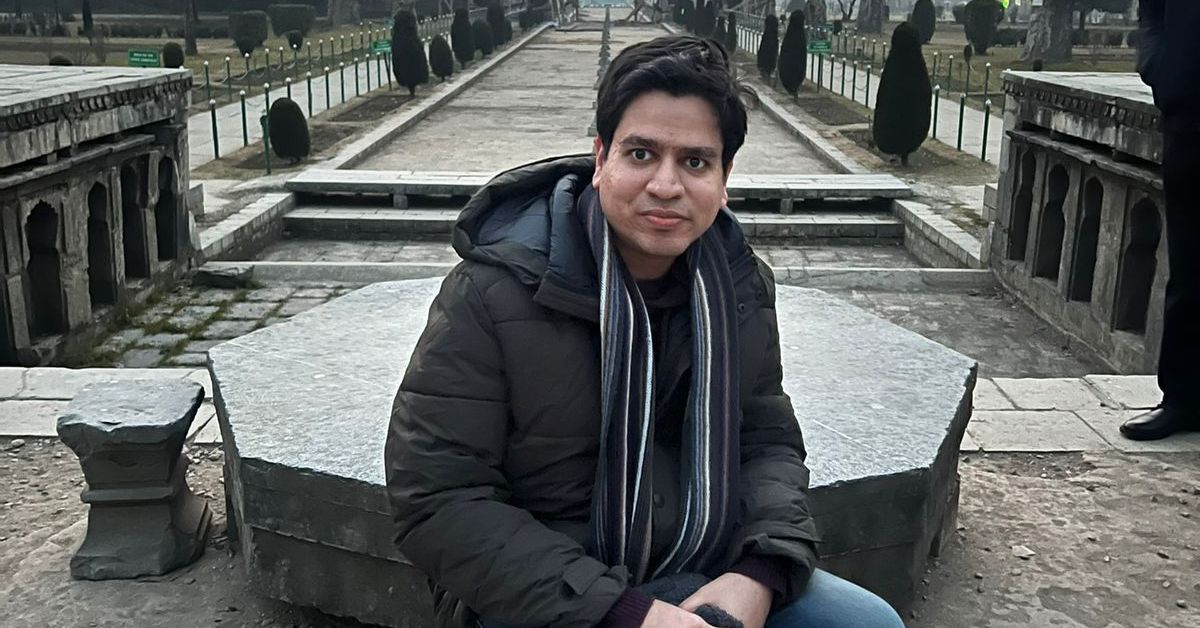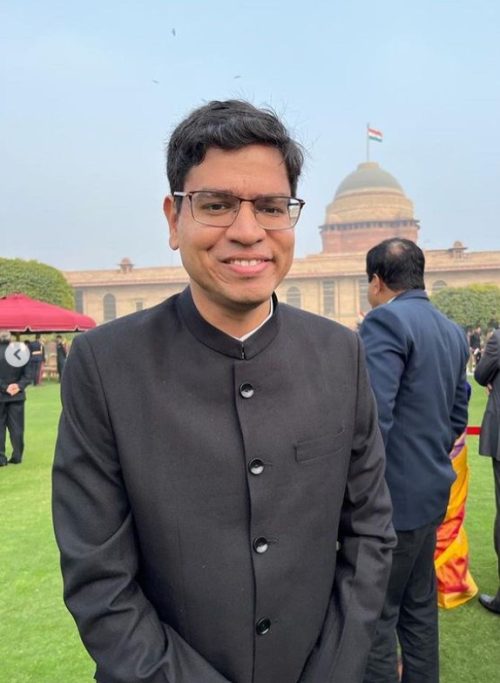How to Ace The UPSC CSE Personality Test? IAS Officer With AIR 7 Shares Tips
Samyak Jain's journey to securing an All India Rank 7 in the UPSC exam was fueled by resilience despite facing progressive vision loss. Today, as an Assistant Collector of Puducherry, he shares effective tips for other UPSC CSE aspirants.

The morning of 30 May, 2022, is still a blur of memory for Delhi resident Samyak Jain. It was the day the UPSC exam results were set to be declared. As Samyak and his parents gathered around the computer screen, refreshing it multiple times eager to watch the score reflect, a million thoughts were racing through his mind.
“Let my name feature in the list,” Samyak shares what he was praying for during those moments of waiting.
An hour later, tears of joy and happiness were being shed as a shocked Samyak still grappled with the fact that he had scored an All India Rank (AIR) 7. Anticipating to feature in the top 100 was an “awesome” thought; believing he would make it to the top 10 was “unthinkable”. It seemed too far-fetched for the young aspirant. Double-checking and triple-checking convinced Samyak that the score was indeed his!
Two years to that day, the 28-year-old catches up with The Better India to retell the iconic story, the road that led to it and why an appetite for success has always fuelled him to give every endeavour his best shot.
An 18-year-old Samyak would have found his current achievements hard to believe.
Diagnosed with a condition that was causing him to lose his vision progressively made him wonder why this was happening to him. But today, as he champions change in his position as Assistant Collector of Puducherry, Samyak sees how every dot connected to bring him to this moment.
While the UPSC CSE is deemed near-to-impossible to crack by some, Samyak says a thorough preparation strategy can help. Here are some tips he shares with other aspirants.
Failure is part of the process
“I did not clear my first attempt in 2020,” Samyak shares. But instead of viewing this as a setback, Samyak saw it as giving way to an opportunity that gave him leverage above others. He began to view this first attempt as a “trial round” that taught him everything he needed to know about “one of India’s toughest exams”.
The mock run, as he calls it, introduced him to the nuances of the exam, the process of applying, how the exam was conducted, the environment in which the exam took place, etc. “These experiences taught me what to do and what to avoid during the second attempt in 2021,” he shares.
Always set a high target
“Reach for the moon. If you miss it, you’ll land among the stars,” — borrowing from this philosophy, Samyak says in his second attempt, he kept the general category cut-off as his goal, instead of the PwD (persons with disabilities) category.
“Usually, the PwD category has a lower cut-off than the general. In my first attempt, I had noticed this and was trying to match this cut-off. But, in my second attempt, I learnt from my mistake and aimed for the general category cut-off.”
Find a holy grail for your optional subject
Preparing for the UPSC is often viewed as nerve-racking by the many aspirants who attempt it every year. But a foolproof plan is what will differentiate you from others, believes Samyak. While choosing an optional subject, he recommends going for something that you are passionate about and know of.
A master’s degree in political science and international relations from JNU (Jawaharlal Nehru University, Delhi) formed the basis for Samyak choosing political science and international relations as his optional.
Notes formed the bedrock of his preparation strategy.
Elaborating on the political science paper, Samyak says it is divided into two parts, with each part featuring two sections. Out of the four sections, three are static (a set of questions that repeat over the years) and one is dynamic (questions that assess your knowledge of current affairs and news).
For the static sections, going through the previous years’ questions suffices, Samyak notes. “The question bank (of notes) has around 2,500 questions that feature ad verbatim, with a few changes,” he adds. This leaves a candidate with the fourth section on which they must spend adequate time. “This section is more challenging than the others,” Samyak shares.
Coaching might not be your cup of tea
Samyak once harboured a dream to become an engineer. It was during this phase when he was preparing for the IIT exam that he attended coaching classes. However, he instantly knew this style of learning wasn’t suited to his temperament. Thus, when it came to the UPSC exam, he decided to study by himself.
Not wanting to dissuade anyone from opting for coaching, Samyak emphasises it merely wasn’t his cup of tea. “To each his own,” he reiterates.
Acing the final frontier — the personality test
The second part of the daunting UPSC exam — the interview round more famously known as the ‘Personality Test’ — is actually designed to test one’s integrity, Samyak emphasises. Take its name seriously.
He goes on to explain that in every interview, there is bound to be a five-minute or 10-minute period when the candidate is grilled and might find themselves on the spot. “Don’t get anxious or fidget with your hands during this time. The examiners are trying to assess how well you perform in real-time high-pressure situations. They are not testing your knowledge but rather your personality,” he shares.
Recalling his own interview, he shares how a casual mention of ‘yellow journalism’ in one of his answers led him to be questioned about it. “I tried to dodge the question a few times. But eventually, the examiner asked me a pointed question as to what I meant and I had to explain,” he says.
Borrowing from this incident, he says there will be times when candidates can be expected to be bombarded with questions they wouldn’t like to answer. “All you need to do is keep calm and composed as you speak,” he advises.

If it seems impossible, you’re doing it wrong
Ever since Samyak began losing his vision, his journey has been fraught with moments of challenge. However, persistence through his personal life taught him to apply the same in his preparatory phase of the UPSC. Nevertheless, there were moments of disappointment.
“Sometimes I wouldn’t score well in my mock tests despite studying hard for them. It would feel disheartening. But, I began to tell myself that if it were seeming impossible, there was something that I was doing wrong.”
He emphasises the importance of smart work rather than hard work.
A recalibration of the strategy followed by discussions with peers would usually prove effective. “I would go through model answer sheets, check how toppers had approached tough questions, and then begin my preparation with a new mindset,” Samyak adds.
But above all, follow your calling
Tasting success in the UPSC exam meant all the more to Samyak who had found the courage to navigate this path after years of exposure to other professional fields. Following Class 12, he began preparing for engineering but dropped out after his first year. He then pursued a BA in English Honors from Delhi University followed by journalism at the Institute of Mass Communication, New Delhi.
It was during this time that Samyak began to get invested in current affairs, particularly the upcoming elections of 2019. Intent to be a part of the mechanism creating change in society, Samyak decided to follow his calling of joining the civil services and registered for the UPSC exam the next year.
He saw this as a stepping stone to getting direct agency that would help him ease the plight of people, and make a tangible difference to society. And this is exactly the message he is upholding in his current post.
With dreams to create impact in areas of pollution, traffic management, and education, Samyak speaks of how losing your vision can change the trajectory of your life. “Challenging circumstances can either break you or make you. Always choose the latter,” he remarks.
Edited by Pranita Bhat.
If you found our stories insightful, informative, or even just enjoyable, we invite you to consider making a voluntary payment to support the work we do at The Better India. Your contribution helps us continue producing quality content that educates, inspires, and drives positive change.
Choose one of the payment options below for your contribution-
By paying for the stories you value, you directly contribute to sustaining our efforts focused on making a difference in the world. Together, let's ensure that impactful stories continue to be told and shared, enriching lives and communities alike.
Thank you for your support. Here are some frequently asked questions you might find helpful to know why you are contributing?














